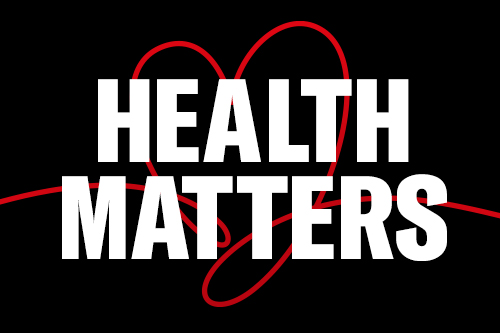
We’ve all felt discomfort in our neck and back. A spine specialist offers simple techniques that anyone can include in their daily routines to keep our backs healthy and pain free.
This week our host, Faith Salie, talks to Dr. Ricky Singh, a specialist in Physical Medicine and Rehabilitation, Sports Medicine and Pain Medicine at Och Spine at NewYork-Presbyterian and Weill Cornell Medicine, about common cause of neck and back issues. Whether it’s from technology use or a sports injury, Dr. Singh offers guidance for what people can do at home to reduce pain and protect neck and back health.
Episode Transcript
Welcome to Health Matters – your weekly dose of the latest in health and wellness from NewYork-Presbyterian. I’m Faith Salie.
We’ve all felt those nagging aches and pains, whether it’s from a long workout or all the hours hunched in front of the computer, or even your phone.
To get some tips on how to avoid common neck and back issues — and how we can treat them at home — I talked with Dr. Ricky Singh, a specialist in sports and rehab medicine at Och Spine at NewYork-Presbyterian and Weill Cornell Medicine.
Dr. Singh walked us through some simple techniques we can all apply to our everyday routines to keep our backs healthy and pain free.
Faith: Hello, Dr. Singh. Thank you for joining us.
Dr. Singh: Hi, Faith, thank you for having me.
Faith: Over the time that you’ve been practicing, we know you’ve seen all kinds of conditions. What are the most common back and neck complaints that people bring to their doctors?
Dr. Singh: Well, 90% of the time we see disc bulge and muscle spasm, you know, postural stuff. Pre-pandemic, I would say I would see about 75% lower back pain. Um, these are people who hurt themselves playing a sport, golf, tennis, things like that, someone who’s lifting up heavy objects, a parent or a grandparent lifting up their kids or grandkids injuring their lower back.
During the pandemic I started to see a lot more upper back and neck pain. So patients who typically don’t have an ergonomic setup at home, uh, they were using the laptop on their bed or on their coffee table, kind of hunched over, stooped their shoulders rounded, their neck going forward, and we’re getting a lot of neck pain.
So we were calling it, you know, text neck or zoom neck, um, mostly neck pain, sometimes causing headaches and migraines. But those are probably the biggest two conditions. I continue to see.
Faith: At this point, as we come out of the pandemic, you’re seeing about 50-50?
Dr. Singh: I still see some Zoom neck but I think the lower back lumbar disc people are getting back to sports. Pickleball and paddleball are picking up, so I’m seeing a lot more injuries from those sports as well.
Faith: What, what does neck and back pain tell us about neck and back health?
Dr. Singh: Yeah, great question. You know, a lot of symptoms around our spine are mostly muscular, you know, soft tissue. It’s not a structural issue with like a disc herniation or a fracture or even arthritis. So, you know, that’s why we don’t need to see most of the patients who suffer from an episode of back pain because the muscles are not balanced.
You know, we if we’re sitting all day, the core is not really engaged. So the muscles stretch, the disc can squeeze a little bit, and the body produces inflammatory cells and cytokines that cause pain. And if we chronically sit in these positions and we develope overuse injuries, then pain, you know, persists.
But if we change that behavior, work on our exercises, get some aerobics, bring some oxygen to those areas, uh, most of these symptoms wane pretty quickly.
You know, we see a lot of athletes here. I treat a lot of marathon runners, a lot of triathletes, lot of CrossFitters, and I quickly learned. Telling one of those athletes that they’re weak doesn’t get me very far. So I’ve kind of changed how I approach that. And I don’t say weak anymore. I say not optimally balanced.
Faith: Boom.
Dr. Singh: So I say you’re super strong and you’re quads super strong in your hamstrings, but you’re glute medias on the outside of your hip muscles are not as strong as they should be. So there’s an opportunity there to correct that balance. Same thing with core. Yeah, I mean, people think core is your six pack. That’s like 20% of it. It’s the deep muscles of the abdomen. It’s your pelvic floor, you know, squeezing those muscles like kegel exercises. It’s your diaphragm, your lower back, doing superhumans and lotus position. Core is your foundation that connects our legs to our upper body, so working all those muscles, very important.
Faith: How can someone know if what they’re feeling is severe and lasting or if it’s just minor and temporary? Because I feel like when any of us has neck or back pain, it just feels like an emergency.
Dr. Singh: Yep. I think the most important thing is how debilitating that pain is. How much has it really impacted your function? I woke up today with back pain. I just told you earlier, before we started recording, I was on a flight overnight sitting in an economy chair. Yeah. That’s not fun. Yeah. So I had some back pain today. And, and I know that with this cycle or flare, it’s probably gonna take a day or two to kind of get normal. And I would say if you’re experiencing back pain or neck pain that lasts more than a few days, that’s really getting in the way of your functionality, you know, you can’t change, you can’t get dressed, it’s tough to toilet, that is probably worth getting checked out. Most of all neck and back pain issues resolve within three months. Most, you know, 85, 95% of the people. And even those that persist longer than that, only five to 10% need anything like an intervention or a spine surgery.
Faith: This is very comforting actually. But I, I wanna pause on something. Three months though, when people want immediate relief, right? Three months can feel like a long time.
Dr. Singh: Right. Right. And that’s, yes. Three months does sound like a lot, especially when you’re in pain. Now I’ve been in pain, even 24 or 48 hours seems like a lot when you can’t do the things you want to do, but it’s all about the level of pain and the severity. And then the other thing I didn’t mention was neurologic symptoms. And that’s when you really want to get checked out. And, and what I mean by that is do you feel weakness in your hands or grip? Is there some tingling or pins and needles going on into your arms or into your legs or into your feet? Are you having issues with bowel or bladder? These are reasons to get seen, you know, sooner. But again, that’s just a minority of the patients that experience these symptoms.
Faith: What are some of the things that people can do safely to relieve neck and back pain for some of the most common complaints?
Dr. Singh: Neck pain isn’t just neck pain isn’t just neck pain. There’s a reason that you have neck pain. And part of the investigative process of seeing one of us or working with a physical therapist or chiropractor is to figure out what that pain is and then how to treat it. So we focus a lot on rehabilitation medicine, which is physical therapy, occupational therapy.
I say, listen, we’re gonna start this treatment regimen with function — strengthening, stretching, and that’s physical therapy. If that doesn’t work, let’s go to level two, which is some type of medication. Is it a muscle relaxer? Is it an over-the-counter anti-inflammatory, um, things of that nature. I’m gonna give you a medication that’s not gonna fix you. It’s gonna help with your symptoms so that you can then go back to phase one, which is exercise.
Because if you’re in pain and I say, oh, you know, you just need physical therapy, you’re not gonna go to physical therapy because it’s hurting too much. So I use medications to bring down that pain, bring down that inflammation. And then say, now go fix the actual problem with physical therapy and exercise.
So usually most patients, 85% of the patients fall into those two categories, physical therapy and some type of medication temporarily. If those don’t work, then we elevate it and escalate it to a more interventional approach, which is injections. And again, I tell patients, Listen, I’m not gonna cure you with this injection. I’m not gonna cure you of your arthritis. But if I get rid of the pain associated with arthritis, you’re going go all the way back down to phase one again, which is exercise.
And every one of my patients knows that. The goal is always to get you back to exercise. And I just use some of these interventions, medications, injections, maybe surgery. Again, that’s, you know, 5% of the patients, all with the aim of functional improvement.
Faith: Okay, so, so while we’re talking about alleviating pain, I’ll ask very specifically: ice versus heat?
Dr. Singh: You know, the science is actually not clear which is actually better for you. Uh, and I tell patients that first, what makes you feel better faster? You know, is it sitting in a heating blanket and a heating pad? Does that speed it up? Go ahead and do that. But for most of the group who hasn’t really experienced one or the other, I’d say jump with cryo first.
Faith: Okay. And not alternate, right?
Dr. Singh: Alternating is great. I mean, I think that’s very important. Yeah. Contrast therapies where you’re doing a little bit of ice, a little bit of heat, that actually speeds up the recovery even faster. It’s time consuming, but contrast bats really helped with inflammation and then the heat for mobility.
Cold therapy is great for acute pain. You know, if, if you wake up and you have a crick in your neck or lower back pain, I would say go to ice first, stop the inflammatory process, because when your body sees something mechanically wrong or posturally wrong, it sends all these inflammatory cells to that site, you know, albeit to help repair issues there. But that comes with a lot of pain and stiffness. So throwing a bag of ice or frozen vegetables or something like that for 20 minutes is gonna help shut that inflammatory process off, help decrease the swelling in that area. It’s after that where heat can really help relax the muscles.
Faith: Would you describe some of the most important things that people can do for their neck and back health
Dr. Singh: Yeah. First is mobility. You know, I say this to almost every patient, mobility is medicine. We have to get you moving because if you don’t move, you’re not gonna bring blood flow and oxygen and nutrients to where they need to be. When we exercise, we take the pressure off that disc and that negative pressure sucks in all these nutrients and oxygen and good stuff. So if we do that all day, sitting and standing. Sitting and standing. So that motion is very helpful for the muscles and the structures around the spine. Same thing with our neck. If we’re sitting at a computer zooming all day and on virtual meetings, it’s very hard to maintain perfect ergonomic setup, but if you give yourself a check, OK, every 15 minutes or every time the phone rings, I need to get up off my chair and decompress my lower back. Mobility. Mobility is medicine. That’s the one thing that I stress the most with every patient. I ask them, how much are you walking?
Faith: I mean, it’s an easy thing to remind people. I also love this idea of the mere act of standing, or not sitting, provides nourishment for our back.
Dr. Singh: Absolutely. You know, that’s, that’s how you engage those muscles when you’re sitting. We’re not really using our core right now. And our disc and our spine is taking all of the forces. When you stand up, the forces around the spine minimize and the muscles engaged to support you. I share with patients and say, this is why your disc hurts. You’re sitting all day. Get up and get up and move around.
Faith: OK. That’s again, simple, relatively easy. Mobility is medicine. Get up and move around. What else? What else can we do for back health?
Dr. Singh: Core strengthening and upper back strengthening. I think these are kind of undervalued as well. You know, once we get the basic foundational motion in place and we’re saying, OK, you’re walking now, you’re walking 30 minutes, five times a week. If you can increase that to a more intense, vigorous exercise, you’re gonna get other benefits, like joint health and cardiovascular health. But at minimum, let’s talk about moving 150 minutes a week at baseline.
One of the best exercises that I go over with my elder adults is sit to stand. So just sitting to standing without using your hands. Being able to engage your core, engage your glutes, and stand up from a sitting position is a wonderful exercise to keep your foundational strength intact. And that actually predicts your ability to ambulate and to walk long term without an assist device, without a cane or a walker.
Faith: So, to whom should folks go if they have questions and, and wanna talk about their neck and back health with someone?
Dr. Singh: I think first and foremost, see your primary care doc. Most of the patients who—if you have experienced an acute episode—will probably be best served seeing a physical therapist. See a physical therapist, occupational therapist, try to see one of us. And then let us refer you out to, you know, a lot of these non-interventional options like chiropractic care, acupuncture and things like that. That’ll probably get you better fast.
Faith: Well, I am grateful for this conversation. Thank you so much, Dr. Singh.
Dr. Singh: Thank you, Faith. It was a pleasure.
Our thanks to Dr. Ricky Singh.
Health Matters is a production of NewYork-Presbyterian.
For more stories of science, care, and wellness visit healthmatters.nyp.org.
The views shared on this podcast solely reflect the expertise and experience of our guests.
NewYork-Presbyterian is here to help you stay amazing at every stage of your life.
Read more
Share This Story

We understand how important it is to choose a chiropractor that is right for you. It is our belief that educating our patients is a very important part of the success we see in our offices.




